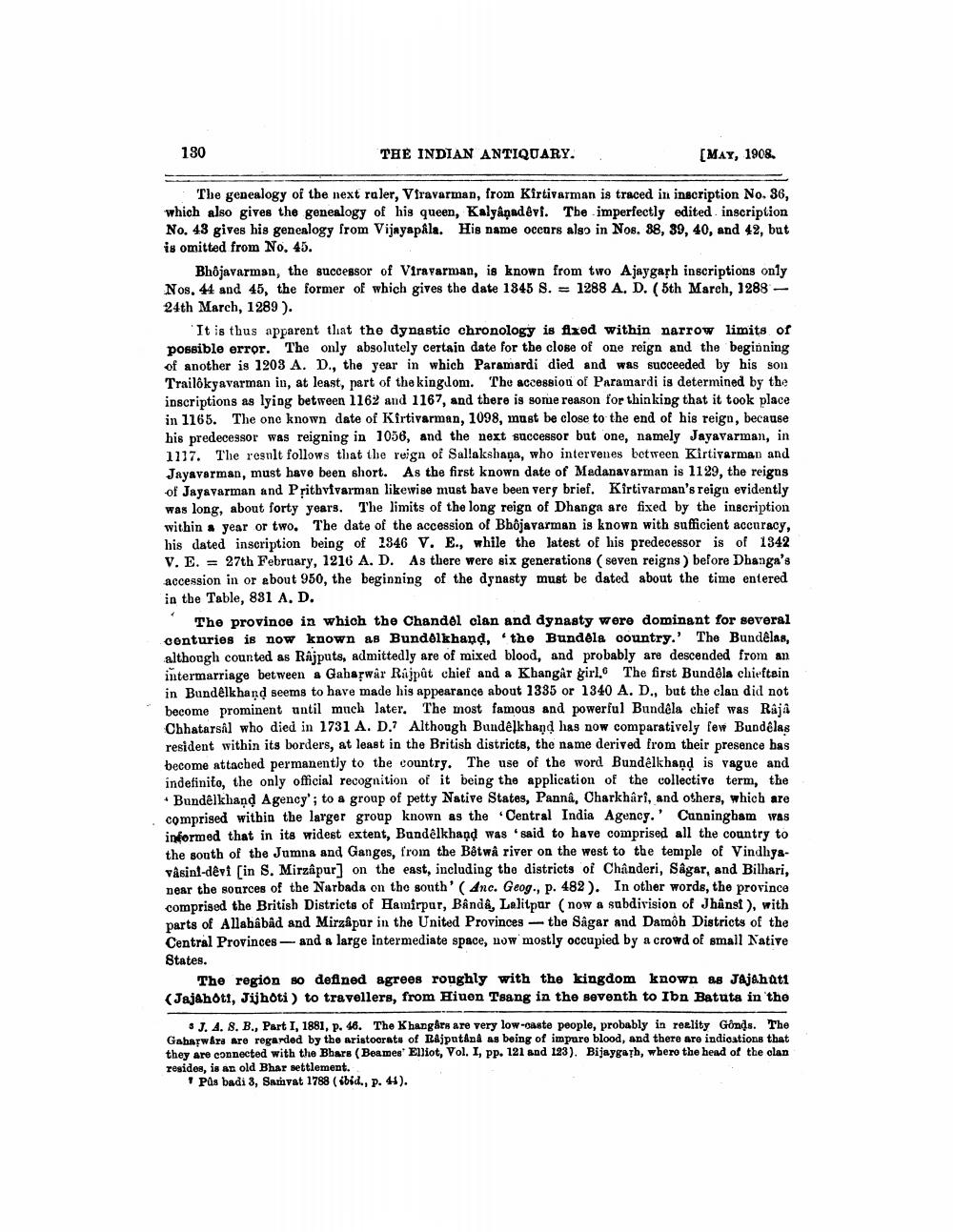________________
130
THE INDIAN ANTIQUARY.
[MAY, 1908.
The genealogy of the next raler, Viravarman, from Kirtivarman is traced in inscription No. 36, which also gives the genealogy of his queen, Kalyaņadevi. The imperfectly edited inscription No. 43 gives his genealogy from Vijayapåla. His name occurs also in Nos. 88, 39, 40, and 42, but is omitted from No, 45.
Bhojavarman, the successor of Viravarman, is known from two Ajaygașh inscriptions only Nos. 44 and 45, the former of which gives the date 1845 8. = 1288 A, D. (5th March. 1288 - 24th March, 1289 ).
'It is thus apparent that the dynastic chronology is fized within narrow limits of possible error. The only absolutely certain date for the close of one reign and the beginning of another is 1203 A. D., the year in which Paramardi died and was succeeded by his son Trailokyavarman in, at least, part of the kinglom. The accession of Paramardi is determined by the inscriptions as lying between 1162 and 1167, and there is some reason for thinking that it took place in 1165. The one known date of Kirtivarman, 1098, must be close to the end of his reign, because his predecessor was reigning in 1056, and the next successor but one, namely Jayavarman, in 1117. The resnlt follows that the reign of Sallakshaņa, who intervenes between Kirtivarman and Jayavarman, must have been short. As the first known date of Medanavarman is 1129, the reigns of Jayavarman and Prithvivarman likewise must bave been very brief. Kirtivarman's reiga evidently was long, about forty years. The limits of the long reign of Dhanga are fixed by the inscription within a year or two. The date of the accession of Bbôjavarman is known with sufficient accuracy, his dated inscription being of 1946 V. E., while the latest of his predecessor is of 1342 V. E. = 27th February, 1216 A. D. As there were six generations (seven reigns ) before Dhanga's accession in or about 950, the beginning of the dynasty must be dated about the time entered in the Table, 831 A. D.
The province in which the Chandel clan and dynasty were dominant for several centuries is now known as Bundelkhand, the Bundela country.' The Bundêlas, although counted as Rajputs, admittedly are of mixed blood, and probably are descended from an intermarriage between a Gabarwar Rajpût chief and a Khangar girl. The first Bundola chieftain in Bundelkhand seems to have made his appearance about 1335 or 1340 A. D., but the clan did not become prominent until much later. The most famous and powerful Bundela chief was Raja Chhatarsal who died in 1731 A. D.7 Although Bundelkhand has now comparatively few Bundelas resident within its borders, at least in the British districts, the name derived from their presence has become attached permanently to the country. The use of the word Bundelkhand is vague and indefinito, the only official recognition of it being the application of the collective term, the • Bundelkhand Agency'; to a group of petty Native States, Panna, Charkhâri, and others, which are comprised within the larger group known as the Central India Agency.' Cunningham was informed that in its widest extent, Bundelkhand was said to have comprised all the country to the south of the Jumna and Ganges, from the Betwå river on the west to the temple of Vindhyavâsint-devi [in S. Mirzapur] on the east, including the districts of Chanderi, Sagar, and Bilhari, near the sources of the Narbada on the south' ( Anc. Geog., p. 482). In other words, the province comprised the British Districts of Hamirpur, Banda, Lalitpur (now a subdivision of Jhûnst ), with parts of Allabâbâd and Mirzapur in the United Provinces - the Sågar and Damoh Districts of the Central Provinces - and a large intermediate space, now mostly occupied by a crowd of small Native States.
The region so defined agrees roughly with the kingdom known 08 Jajahati (JajAhoti, Jijhoti) to travellers, from Hiuen Tsang in the seventh to Ibn Batuta in the
8 J. A. 8. B., Part I, 1881, p. 46. The Khangars are very low-caste people, probably in reality Gônds. The Gabawfra Are regarded by the aristocrats of Rajputand as being of impure blood, and there are indioations that they are connected with the Bbars (Beames Elliot, Vol. I, pp. 121 and 123). Bijaygah, wbero the head of the olan resides, is an old Bhar settlement.
" Pas badi 3, Sanyat 1788 (ibid., p. 46).




